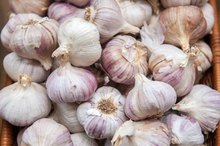Foods That Increase White Blood Cells
The body relies on its immune system to fight invaders called antigens, which include bacteria, viruses and allergens. White blood cells attack these harmful organisms, allowing the body to maintain its health. Proper nutrition is key when it comes to maintaining your immune system 1. Essential vitamins and minerals increase the production and strength of white blood cells, thereby giving your immune system the power it needs to fight infection 1. Fortify your diet with foods that contain these vitamins and minerals to boost your body’s defense against unwelcome invaders.
Fruits and Vegetables
Carotenoids are also necessary for optimal functioning of the immune system. Beta carotene, one of the most well-known carotenoids, boosts the production of infection-fighting cells and T-cells. Fruits and vegetables high in beta carotene include:
- carrots
- squash
- pumpkin
- sweet potatoes
- mangoes
- apricots
Other carotenoids include lutein (found in dark green vegetables) and lycopene, which is found in tomatoes, pink grapefruit and guava.
Nuts and Seeds
Can Certain Vegetables Increase Your White Blood Cells?
Learn More
Vitamin E aids in the production of B-cells, white blood cells which hunt for and destroy germs and cancer cells. Nuts, seeds and vegetable oils contain large quantities of vitamin E; leafy greens are also a good source. Eat foods like almonds, sunflower seeds, peanut butter, spinach and broccoli to get more vitamin E.
Lean Protein
Protein contains amino acids, which are the building blocks of white blood cells. Without adequate amounts of protein, the body cannot produce enough white blood cells to fight off antigens. High quantities of protein are found in lean meats, such as seafood, fish, and skinless poultry. Eggs, beans, lentils and soy are also good sources of protein.
- Protein contains amino acids, which are the building blocks of white blood cells.
- High quantities of protein are found in lean meats, such as seafood, fish, and skinless poultry.
Fish and Flax Oil
Can Foods Raise White T Cells?
Learn More
Fatty fish, including tuna and salmon, and flax oil are rich in omega-3 fatty acids. Omega-3’s are a beneficial kind of fat that boost the immune system by increase the germ-eating activity of white blood cells. Flax oil can be added to fruit smoothies.
- Fatty fish, including tuna and salmon, and flax oil are rich in omega-3 fatty acids.
Dark Meat and Shellfish
Dark meat and shellfish are high in zinc. Zinc helps the body produce more white blood cells and makes existing white blood cells more aggressive. Foods like dark turkey meat, beef, oysters and crab contain high amounts of zinc. You can also get zinc from beans and fortified cereals.
- Dark meat and shellfish are high in zinc.
- Foods like dark turkey meat, beef, oysters and crab contain high amounts of zinc.
Garlic
Ward off invaders and add some kick to your diet with garlic. A member of the onion family, garlic stimulates the production of white blood cells and antibodies.
Related Articles
References
- Ask Dr. Sears: Feeding Your Immune System
- The World's Healthiest Foods: Essential Nutrients
- Mayadas TN, Cullere X, Lowell CA. The multifaceted functions of neutrophils. Annu Rev Pathol. 2014;9:181-218. doi:10.1146/annurev-pathol-020712-164023
- Mcbrien CN, Menzies-gow A. The Biology of Eosinophils and Their Role in Asthma. Front Med (Lausanne). 2017;4:93. doi:10.3389/fmed.2017.00093
- Cromheecke JL, Nguyen KT, Huston DP. Emerging role of human basophil biology in health and disease. Curr Allergy Asthma Rep. 2014;14(1):408. doi:10.1007/s11882-013-0408-2
- Hoffman W, Lakkis FG, Chalasani G. B Cells, Antibodies, and More. Clin J Am Soc Nephrol. 2016;11(1):137-54. doi:10.2215/CJN.09430915
- Karlmark KR, Tacke F, Dunay IR. Monocytes in health and disease - Minireview. Eur J Microbiol Immunol (Bp). 2012;2(2):97-102. doi:10.1556/EuJMI.2.2012.2.1
- Görgens A, Radtke S, Horn PA, Giebel B. New relationships of human hematopoietic lineages facilitate detection of multipotent hematopoietic stem and progenitor cells. Cell Cycle. 2013;12(22):3478-82. doi:10.4161/cc.26900
- Hong JW, Noh JH, Kim DJ. Association between White Blood Cell Counts within Normal Range and Hemoglobin A1c in a Korean Population. Endocrinol Metab (Seoul). 2018;33(1):79-87. doi:10.3803/EnM.2018.33.1.79
- Riley LK, Rupert J. Evaluation of Patients with Leukocytosis. Am Fam Physician. 2015;92(11):1004-11.
- Flores-mireles AL, Walker JN, Caparon M, Hultgren SJ. Urinary tract infections: epidemiology, mechanisms of infection and treatment options. Nat Rev Microbiol. 2015;13(5):269-84. doi:10.1038/nrmicro3432
- Kasi PM, Grothey A. Chemotherapy-Induced Neutropenia as a Prognostic and Predictive Marker of Outcomes in Solid-Tumor Patients. Drugs. 2018;78(7):737-745. doi:10.1007/s40265-018-0909-3
- U.S. Library of Medicine. MedlinePlus. White Blood Cell Count. https://medlineplus.gov/ency/article/003643.htm
Writer Bio
Jenna Foote began her career as an online writer for CBS 5 News in Phoenix. Her work has been published on various websites, covering consumer and recreational topics. Foote holds a Bachelor of Arts in communications from Brigham Young University.









